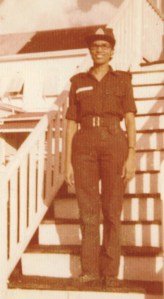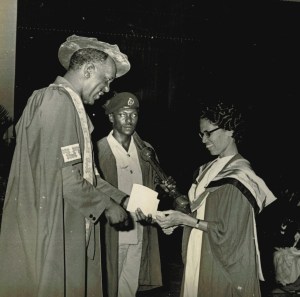Tags
Cooperative socialist policies, Georgetown/Guyana, Guyana National Service (GNS), High School Teacher, Nation building, National Service, Paramilitary Organization, University graduates, University of Guyana
 Rosaliene in Guyana National Service Uniform, 1976
Rosaliene in Guyana National Service Uniform, 1976
When Guyana’s first Executive President created the Guyana National Service (GNS) in October 1973, he had a vision for “a new Guyana Man and Woman, oriented towards their role in nation building.” He had envisaged a nation working together, with respect for each other, to develop our hinterland regions and defend our territory (1973 State Paper of the GNS, www.guyanapnc.org).
Over the next twenty six years of the paramilitary organization’s existence, thousands of Guyanese youth spent a year or more at GNS hinterland centers cultivating and processing cotton, black-eye beans, peanuts, and other cash crops. For young men and women without job prospects, the GNS provided an opportunity to learn and develop new skills.
When the first GNS hinterland center began operations, I was a second-year undergraduate at the University of Guyana. In my final year, completion of one year of national service became a requirement for obtaining a university degree. Caught in the change, graduates 1976 were required to complete only three months of national service.
With reservations about my safety, I resisted the requirement of spending three months in an isolated location in Guyana’s jungle interior. Moreover, I was a high school teacher, already doing my part in preparing our young people for their place in our young nation. Even though I had sacrificed a lot to attend university classes in the evening while teaching during the day, I was prepared to forfeit it all to avoid placing myself in harm’s way. I was not ready for such a sacrifice. Then the good news came. We would be serving in Georgetown, the capital.
The first weekend that we assembled at the GNS Center in Sophia, we formed a unified mass in our parrot-green uniforms issued by the GNS. My name badge bore only my family name: Fung. Divided into four units, each under the command of a GNS Officer, we spent our weekends studying cooperative socialist policies for nation-building; doing marching drills and physical training; and engaged in agricultural activities.
Mondays to Fridays, we served at various government agencies. I worked with six other graduates at the Guyana National Service Printing Center, setting up a staff library and executing other duties.
Under the tutelage of army sergeants from the Guyana Defense Force, we had to conform to military modes of conduct. I was relieved that we did not have to train with rifles. Our platoon had a tough, buxom, female sergeant with a booming voice.
“Fung, fall in line!”
Within three months, from July to October, she transformed our platoon into a marching unit for a top-notch performance at our Passing out Parade – held in October at the University of Guyana Turkeyen Campus.
Completing those three months of national service was an achievement for me. I had survived the marching drills, physical training, and agricultural work under the merciless Sun. Later that October, when we assembled in the auditorium of the Guyana National Cultural Centre for our graduation ceremony, we were no longer strangers.
“Fung, to the front!”
 Rosaliene receiving Chancellor’s Medal – University of Guyana 1976
Rosaliene receiving Chancellor’s Medal – University of Guyana 1976

Reblogged this on Guyanese Online.
LikeLike
Thanks for sharing, Cyril. Much appreciated.
LikeLike
With time your writing is getting there.
Sent from my iPhone
LikeLike
Thanks for reading, Jerry.
LikeLike
Thanks for sharing your experience which is alien to me, everyday I am learning something about your myriad of experiences as I read your work. I lived in the North at that time. great contributions Ros.
LikeLike
Thanks, Yvonne. Life dishes out all kinds of surprises: some good, some bad. I know that you, too, have had your share of the unexpected.
LikeLike
Loved this Rose – reminded me of the heady, idealistic days of the Peace Corps which several of my friends joined in the late 60s. Not me, though, I had already married my first husband before my 3rd year of college and unhappily saw my friends off at the airport. But like you said, more adventures were to come.
LikeLike
Angela, Peace Corps workers continue to do a fine job in Guyana and throughout the world.
LikeLike
Joseph, I have no record of your comment to this post. I don’t know what happened. Could you please re-post.
Thanks. I appreciate hearing from you.
LikeLike
Very informative for the young Guyanese guess will bring back some discipline in the country.
LikeLike
Thanks for dropping by, Christel. Yes, it would. The GNS would also offer young people a chance at developing new skills for personal and national development. On the other hand, there was the downside of sexual abuse that made parents, especially those of the Indo-Guyanese community, fearful for the safety of their young daughters. In my view, this issue would have to be addressed before there could be any serious consideration of bringing back GNS.
LikeLike